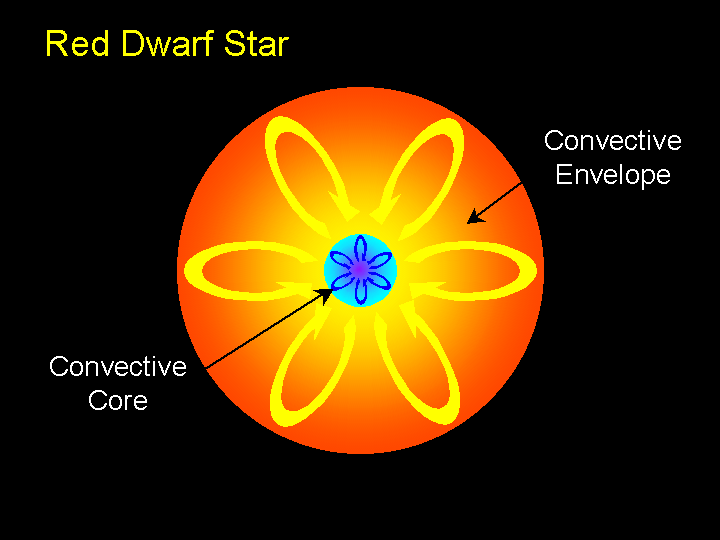Evolution of Star of 0.5
Solar Masses or Less
By: Garvin Peters

Depiction of red dwarf EV Lacertae during one of the largest flares recorded.
Brief Summary on How Stars are Born
Stars are born in clouds of dust and hydrogen gas that are very common throught the many Galaxies. Due to turbulence deep within these clouds, knots of gas and dust begin to form. Eventually these knots will gain enough mass to collapse under it own gravity, and further pulll more gas and dust to it's center. As this happens, there is a build up of heat at the core. This "proto-star" will one day become a real star (when the growing gravitational force will finally cause the hydrogen to react to create the pressure necessary to counter the gravitational force). Not all of the materials will be used in the process of creating the star however. The remaining dust can form asteroids, planets, and so on.
.jpg)

Orion (left) and the Crab (right) Nebulae (clouds of gas, dust and plasma)
The Low Mass Stars
The stars i will be focusing on are those that are of 0.5 solar masses or less. When We look at the Hertsprung-Russell diagram, most stars lie along the main-sequence line. 90% of all stars lie in this area, because most stars spend approximately 90% of their life in their hydrogen-burning phase. The top of the main sequence area contains the stars with the greatest mass that are burning hydrogen, and the low end of the sequence contains low mass stars. The lower end is hard to study not because they are rare, but because they are extremely dim.
Reactions in a Star
To stay balanced, a star usually creates enough internal pressure to counter the gravitational force acting on the star. A star's Hydrogen fusion combines four nuclei into one helium. ALthough each Helium Nucleus can exert the same amount of pressure as one Hydrogen nucleus, the gas has fewer nuclei. Thus the gravitational force acting on the star will overpower the internal pressure of the star, causing it to squeeze the star more. When the core contracts, the temperature and density increase, causing the nuclear reactions to burn faster. The excess of energy forces the outer layer to expand and cool, so the star becomes slightly larger and brighter.

The Hertsprung-Russell Diagram
The Lifespan of a Low Mass Star
The larger the star is, the more hydrogen it burns. That's why the largest stars (such as 15 solar masses and up) have very short lives. Low mass stars like the Red Dwarf (approximately .4 solar masses) , however, have an advantage over larger stars. Firstly, since their masses are so low, their gravitational force is very low, so the amount of internal pressure is relatively low. Thus, the hydrogen reserves of a red dwarf burns very slowly throughout it's lifetime. The Red Dwarves usually have life spans that range (on average) from about 200-300 billion years. Since our universe is only about 14 billion years old, all red dwarfs are expected to be alive to this date.


Depiction of a Red Dwarf Red Dwarf compared to the Sun
The second advantage of the Red Dwarf is that they are totally convective (they are stirred by circulating hot gas currents from the interior with the cool gas of the surface). Because the star is always being circulated, it will never develop a helium core and a Hydrogen shell, keeping them from becoming giant stars. If they did become giant stars, it would result in a greater amount of Hydrogen fusion.

How the Red Dwarf circulates it's gases
Extremely Low Masses
We have learned that stars of 0.5 solar masses or less have lifespans longer than any other star (such as the Red Dwarf), but what happens when the mass gets really low?
Stars of .08 Solar masses or less, called Brown Dwarfs, are not massive enough to create Hydrogen fusion. Because of the low gravitational force and internal pressure, the core never becomes hot enough to start fusion. There has been controversy as to whether or not Brown Dwarfs are stars or planets, because it doesn't start hydrogen fusion like other stars, and it isn't formed from the accumulation of solid bits of matter in disk-shaped nebulae around stars like normal planets.

two very cold brown dwarfs orbiting the stars HD 3651 (left) and HN Peg (right)
In The End..
To sum it all up, our low mass stars can live for hundreds of billions of years as very dim red stars (and if the mass is low enough, as a Brown Dwarf). A .1 Solar mass Red Dwarf would even live to be 6 trillion years old!Since our universe is still relatively young, they should all be alive and burning (Hydrogen of course). But when it comes time for them to die, they will die a very slow, uneventful end...
Comments (0)
You don't have permission to comment on this page.